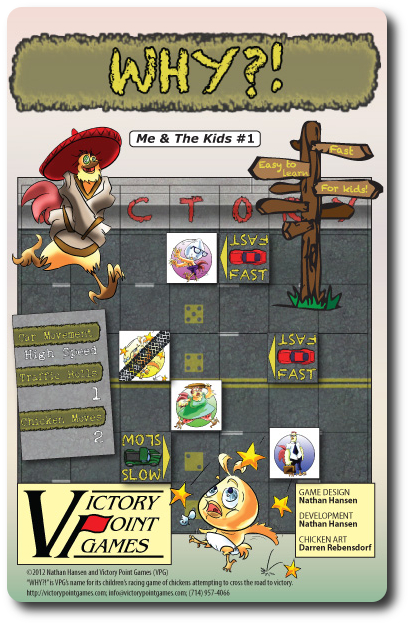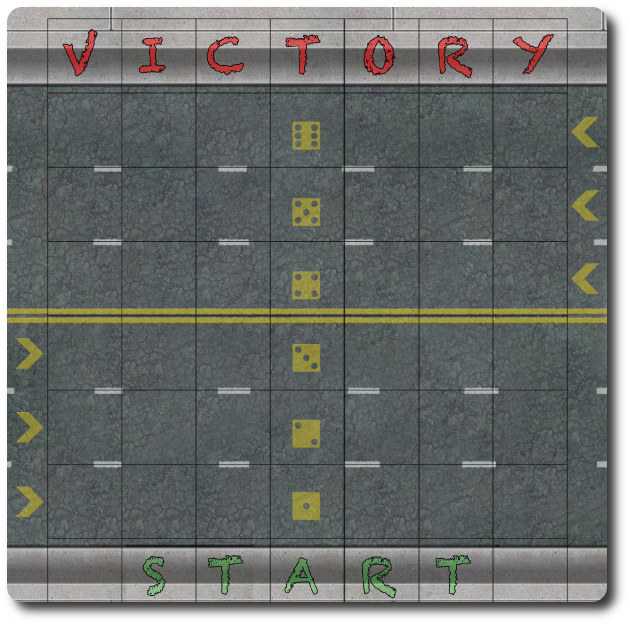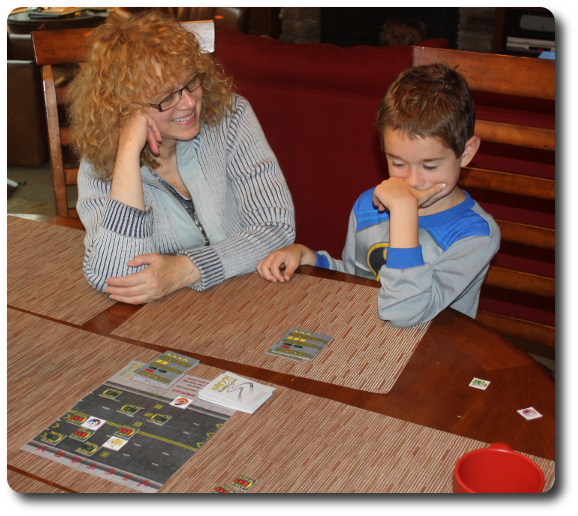
The Basics:
- For ages 7 and up (publisher suggests 8+)
- For 1 to 5 players
- About 15 minutest to complete
Geek Skills:
- Counting & Math
- Logical & Critical Decision Making
- Risk vs. Reward
- Visuospatial Skills
Learning Curve:
- Child – Easy
- Adult – Easy
Theme & Narrative:
- Help your chicken cross the road and avoid traffic at all costs! Or…*splat!*
Endorsements:
- Gamer Geek rejected!
- Parent Geek approved!
- Child Geek approved!
Overview
Why did the chicken cross the road? Many scholars since time immemorial have ponder this. To this very day, heated debates among learned men and women rage in academic arenas. The Human Race might never know and perhaps that is for the best. Until that day comes when the greatest mystery in the universe is solved, have fun simply trying to safely cross said chicken across said road. Do so, and breathe a sigh of relief. Fail, and…well…there are plenty of chickens in the world.
Why?!, by Victory Point Games, is comprised of 1 game board that represents the road, 35 cardboard square game pieces (15 fast cars, 15 slow cars, and 5 chicken characters), 20 Event cards, and 1 small six-sided die. The entire game comes in a small plastic bag which makes it exceptionally portable, easy to put away, and even easier to store.
Game Set Up
To set up the game, unfold and place the game board in the middle of the playing area. Shuffle the Event cards and place, face-down, on the “Event Card Draw Pile” space on the game board. Randomize the car squares (30 in total) and either place them face-down to the side of the game board or (the preferred method) place the square game pieces in a bag or a cup. Regardless of the method selected, this area is referred to as the “car pool”.
Chicken character selection and placement will depend on the number of players. If the game is being played by one person (solitaire), all 5 chickens are used and placed on the start space of the game board. For a 2-player game, each player takes 2 chickens. For a 3-player, 4-player, and 5-player game, each player takes 1 chicken and places them on the start space of the game board. There is no difference in the chicken other than the artwork.
Next, draw the first three Event cards and resolve the noted car movement and traffic rolls. These Event cards are discarded after use and seed the game board with the initial traffic. None of the chickens are moved at this time.
Choose the first player (or if playing solitaire, choose yourself), and get ready to play!
Playing Chicken
On a player’s turn, they will draw an Event card. The Event card provides three important pieces of information: car movement, traffic rolls, and chicken moves. Once the Event card is resolved and all players have moved their chickens (if possible), the Event card is discarded.

Example of one of the Event cards in the game
Car Movement
The Event card identifies the color of the cars to be moved in each of the six lanes and the number of times they will be moved. For example, if the Event card shows 2 red cars, then all red cars currently on the board will be moved 2 spaces. When cars move, they must maintain a safe driving distance of at least 1 space between each car at all times. A car must stop prior to entering a space right behind the car in front of it even if the noted movement would allow it to go further. Cars that move off the board are simply added back to the car pool.
All red cars move first (being the fastest) and then all green cars move. This is repeated in lanes 1 through 6 until all cars have a chance to advance. If there are no cars of that color in the lane, then there simply is no car movement of that particular type for this round.
Red cars are more frequently displayed on the Event cards and move further. Green cars are less frequent and move shorter. This turns out to be just enough information for the player to do some simply risk analysis when determining where they should or should not move.
Traffic Rolls
Traffic is constant on the road and the Event cards make certain there is always a supply of new cars to duck, dodge, and run from. The Event card will show 1 or more die icons. The number of icons is important, not the number on them (i.e. you do not add the values noted on the dice faces). Each die icon represents the number of times the die is rolled (i.e. 2 dice means roll the six-sided die twice). The rolled value on the die will indicate which lane on the road will be get a new car. For example, if the die value rolled is a “4”, the fourth lane gets a new randomly selected car from the car pool.
For each roll, the player will randomly select a single car square from the car pool and place it on the starting position of the rolled lane. Note that cars must always maintain legal distance (as noted in the car movement above). If the car being added cannot maintain the distance of one space between it and the car in front of it, the car is not added to the lane and the die roll is not done again.
Chicken Moves
The number of chicken icons on the Event card identifies how many moves each chicken, starting with the player who drew the Event card, can now move their chicken square on the game board. Chickens can move sideways 1 or 2 spaces at most. When moving forwards or backwards (in relationship to the Victory Lane on the game board), they can only move 1 space. This means that a chicken must zig-zag its way across traffic to get to the other side of the road. Moving forward means the player’s next movement must be to the left or right and vice versa.
Obviously, chickens cannot move into or through a space with a car, but they can move through a space occupied by another chicken as long as they don’t end their movement in a chicken occupied space. Chickens are welcome to go anywhere else that is free on the road, but most follow the movement rules. This means that sometimes the best way to move forward is to go backwards. This is especially true when traffic is getting close and moving to a previous lane makes more sense.
Once all the chickens have moved, the current Event card is discarded and a new Event card is drawn by the next player.

The game board is comprised of 6 lanes of traffic - each as deadly as the one before it and after it
Chicken Death Most Fowl
Despite a player’s best intentions, their chicken might become roadkill or simply panic and keel over from the stress.
If a car should ever end its movement or pass through a space where a chicken is currently located, it is instantly flattened in a cloud of feathers.
If a chicken cannot move on its turn at least once (forward, backwards, or sideways), the chicken keels over from the stress and collapses right there on the road.
When playing a 2 or more player game, the chicken is taken off the board and returned to its initial starting position. When playing a solitaire game, the chicken square is flipped over revealing a flattened chicken. This space can be moved through by other chickens, but cannot be stopped on. Cars are oblivious to the chicken pancake now on the road and pass through it or end their movement on it without a care in the world.
Victory!
As soon as a player moves all of their chickens into the Victory Lane (successfully crossing their chicken across the road), the game ends and that player is declared the winner. For a 3, 4, and 5-player game, this means only one chicken needs to make it to the Victory Lane to complete the game. For a 2-player game, the player must successfully move both of their chickens to the Victory Lane.
For a solitaire game, once all the surviving chickens have crossed into the Victory Lane, the player calculates their score. Every surviving chicken is worth 20 points. Roadkill chickens are worth the number of points equal to the lane they were flattened. For example, a roadkill chicken in lane 3 is worth 3 points. Add up all the numbers and record the score. Try again to attempt to score higher. A perfect game is a high score of 100 points.
To learn more about Why?!, see the game’s official web page.
Prediction
Now here is a game that is going to provide the player an overwhelming sense of accomplishment or a smart kick to the stomach leaving the player feeling bruised and disappointed. The game is random to the extreme, but not to a point where a player is left without any decisions to make. From just reading the rules, I think this game is sounding like a real brain teaser where logical and critical decision making is a must. The trick is going to be getting my family and friends to see it for what I think it is versus them falling into the assumption that this is just a terribly random game.
Teaching the game takes all of 2 minutes to explain and the icons on the Event cards make it easy for players of all ages understand what actions are required. My little geeks understood the game rules and were ready to get started in less than 5 minutes. The only questions I had was about chicken movement which was quickly addressed and successfully answered to the satisfaction of all who asked.
As my 7-year-old set up the game, I asked my two little geeks what they thought of the game so far.
“Why did the chicken cross the road, Dad? To win the game!” ~ Liam (age 7)
“My chicken is going to win the race!” ~ Nyhus (age 4)
Chickens, to your mark! Ready, set, RUN!!!!
Final Word
My 7-year-old had no problem playing this game. He was able to anticipate the movement of the traffic and put a safe distance (when possible) between his chicken and car bumpers. My 4-year-old did not do as well. While he was able to grasp the movement rules with no issue, he simply moved his chicken where it was possible and not to a location that was logical. As a result, his chicken was run over more times than he or I cared to count. This left him exceedingly frustrated and he eventually walked away from the table.
The adults also enjoyed the game. The Parent Geeks liked how the game randomized itself and made the players constantly react to the ever shifting traffic lanes. More than once, adult players stated that the game reminded them of the 1980’s video game, Frogger. I, too, also recognized the similarities and actually enjoyed the game more because of it.
Gamer Geeks, laughed at the idea of chickens being run over and never took the game seriously. They said it was a “good enough” game, but not one that really allowed them to do anything other than react and make choices given a very limited playing field. When a chicken died, it just started over which they found to be tedious. Victory simply went to the luckiest player, in their opinion, and not the most skilled. They also didn’t care for how the traffic roll icons were represented. They commented that the rules were confusing on this point and the icons didn’t clearly communicate what the action should be. For example, having three dice with a total value of “6” (if counting the die face values) was nowhere near what was really intended, which was roll the dice three times. I agree on this point and think this can easily be improved by simply putting three dice icon (like a cube with no numbers) repeated a number of times to communicate required die rolls.

As my little geek contemplates his next chicken move, his grandma geek looks on
Gamer Geeks, this is a pretty random game but it does require a good deal of logical and critical thinking. Unfortunately for you, the level of thinking is not very high. Choices are limited by random card draws and the challenge comes in making choices that allow for forward movement while balancing the possible risk of being run over. Lighthearted and fast, but not deep or rewarding. At best, a game to be played as a quick filler, but for the most part, a game to be missed for those who are searching for a more challenging and rewarding game experience. Considering this is a game designed with the intended players being kids and their parents, this should come as no surprise.
Parent Geeks, this is a fast and easy game to play with the family. The rules are light and the game play is simple enough for gamer and non-gamers alike to quickly understand and play. The game is tongue in cheek, but don’t be surprised if players throw their hands up in disgust. The random traffic makes the game difficulty the same for all players and the only thing that separates victory from flattened defeat is lucky foresight. The game will be thoroughly enjoyed as a quick game to play at the table as it takes little time to set up. Because of the solitaire play, you can sit down with your youngest little geeks and play the game as a cooperative experience, where both you and your little geek talk about what moves to make. This is a great way to get your children interested in games without having them feel overwhelmed.
Child Geeks, your chicken will be hit. It is inevitable. There is simply too much traffic for a chicken to be crossing the road safely. Luckily, you are smart enough to help them cross. It’s just too bad the chicken wasn’t smart enough to NOT attempt to cross the road in the first place. You might find the game frustrating at first as you learn all the different ways the traffic moves. But don’t get too bothered by it. Even if your chicken gets hit, it is easy enough to recover and start again.
Why?! is an interesting game to put in front of the family. The game plays you, to a certain extent, and you are simply trying to move within the cracks of where the game does not dictate the action. As a Gamer Geek, this frustrated me beyond measure. I found the game to be exceedingly random making all of my choices trivial. This left me with a bad taste in my mouth from a gamer elitist’s point-of-view. As a Parent Geek, however, I loved it. The game is chaotic and fun with the little geeks and with adults. It moves fast and I found myself standing up in excitement and apprehension when a new Event card was drawn. The little geeks also really enjoyed the game, but I think it is not one they would play again and again. The game takes its toll on you and leaves you feeling winded and somewhat abused, depending on how badly your chicken was treated on the road. Still, the game left me feeling satisfied and I ended up rethinking and playing a few games of solitaire to try out some different tactics. Of strategy, there is none to be used. There is never a “safe lane”, only “safer lanes” in comparison to the other lanes around it. The true tactical mind will quickly realize that victory can be found by making haste to move to positions where the probability of being hit is less likely, but never avoidable. Understanding the probability of car movement based on their speed is the only way you can hope to avoid being hit. Hardly a “sure thing”, but enough to make somewhat important choices.
So why did the chicken cross the road? We might never know. Until this question is answered, I am more than happy to keep playing this game with my little geeks and with friends when a light game of risk and luck is just right for the mood and the players.
This game was given to Father Geek as a review copy. Father Geek was not paid, bribed, wined, dined, or threatened in vain hopes of influencing this review. Such is the statuesque and legendary integrity of Father Geek.



